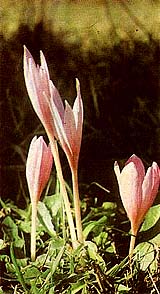Autumn crocus, Meadow saffron
Colchicum autumnale There is an old legend telling about a mystical land called Colchis. It was where famous poisoners lived. In a secret garden, full of poisonous plants and herbs, grew a magic plant, the favorite flower of the most beautiful poisoner Medea. |
A thousand years later, Carl Linnaeus named that plant after this wonderful place. Actually this plant is widespread on the meadows and grasslands in Europe and the Middle East.
The autumn
crocus looks like an ordinary crocus, only it has pink-violet blossoms
and up to 30 cm long leaves. It provoked interest even in ancient times not only because it blooms in the autumn and its fruits appear in the spring, in contrast to the other flowers. Four thousand years ago it was already known to Egyptians, Indians, Greeks, and Arabians as a quite successful but, unfortunately, dangerous means of treating gout and rheumatism. |
|
All parts of the plant are deadly poisonous. The toxic effects appear slowly and gradually within 3 to 6 hours. These are nausea, excessive vomiting and bloody diarrhea, abdominal pain, weak arrhythmic pulse, low body temperature, shortage of breath and, eventually, death. The bulb of the plant contains the alkaloid colchicin, which is still used in the treatment of gout. It is also used in genetics because of its property to cause polyploidia. Colchicin pre-treatment of seeds leads to numerous mutations of plants and is used for selective purposes in agriculture.

